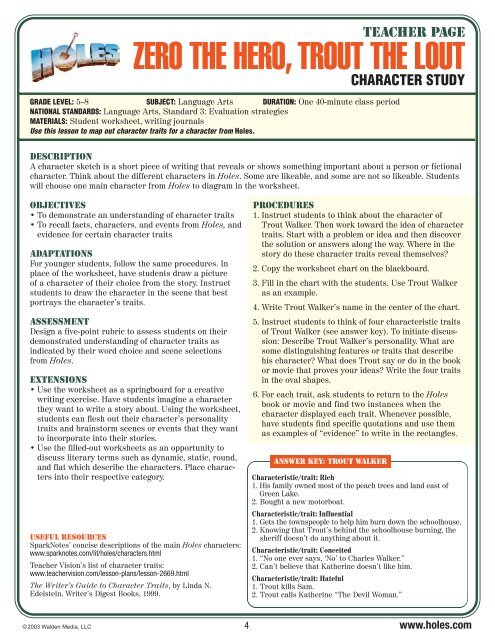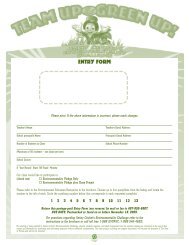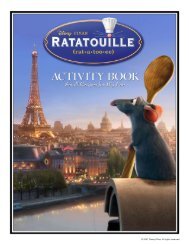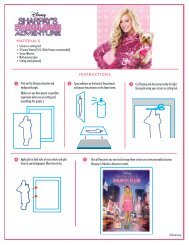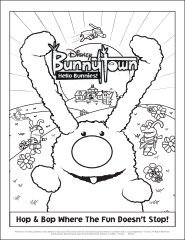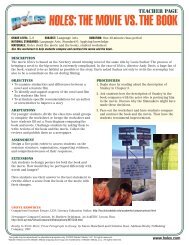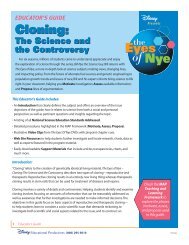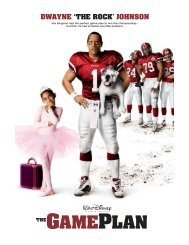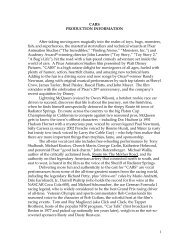Holes Educator's Guide - GO.com - Disney
Holes Educator's Guide - GO.com - Disney
Holes Educator's Guide - GO.com - Disney
Create successful ePaper yourself
Turn your PDF publications into a flip-book with our unique Google optimized e-Paper software.
Teacher Page<br />
ZERO THE HERO, TROUT THE LOUT<br />
CHARACTER STUDY<br />
GRADE LEVEL: 5–8 SUBJECT: Language Arts DURATION: One 40-minute class period<br />
NATIONAL STANDARDS: Language Arts, Standard 3: Evaluation strategies<br />
MATERIALS: Student worksheet, writing journals<br />
Use this lesson to map out character traits for a character from <strong>Holes</strong>.<br />
DESCRIPTION<br />
A character sketch is a short piece of writing that reveals or shows something important about a person or fictional<br />
character. Think about the different characters in <strong>Holes</strong>. Some are likeable, and some are not so likeable. Students<br />
will choose one main character from <strong>Holes</strong> to diagram in the worksheet.<br />
OBJECTIVES<br />
• To demonstrate an understanding of character traits<br />
• To recall facts, characters, and events from <strong>Holes</strong>, and<br />
evidence for certain character traits<br />
ADAPTATIONS<br />
For younger students, follow the same procedures. In<br />
place of the worksheet, have students draw a picture<br />
of a character of their choice from the story. Instruct<br />
students to draw the character in the scene that best<br />
portrays the character’s traits.<br />
ASSESSMENT<br />
Design a five-point rubric to assess students on their<br />
demonstrated understanding of character traits as<br />
indicated by their word choice and scene selections<br />
from <strong>Holes</strong>.<br />
EXTENsIONS<br />
• Use the worksheet as a springboard for a creative<br />
writing exercise. Have students imagine a character<br />
they want to write a story about. Using the worksheet,<br />
students can flesh out their character’s personality<br />
traits and brainstorm scenes or events that they want<br />
to incorporate into their stories.<br />
• Use the filled-out worksheets as an opportunity to<br />
discuss literary terms such as dynamic, static, round,<br />
and flat which describe the characters. Place characters<br />
into their respective category.<br />
USEFUL RESOURCES<br />
SparkNotes’ concise descriptions of the main <strong>Holes</strong> characters:<br />
www.sparknotes.<strong>com</strong>/lit/holes/characters.html<br />
Teacher Vision’s list of character traits:<br />
www.teachervision.<strong>com</strong>/lesson-plans/lesson-2669.html<br />
The Writer’s <strong>Guide</strong> to Character Traits, by Linda N.<br />
Edelstein, Writer’s Digest Books, 1999.<br />
PROCEDURES<br />
1. Instruct students to think about the character of<br />
Trout Walker. Then work toward the idea of character<br />
traits. Start with a problem or idea and then discover<br />
the solution or answers along the way. Where in the<br />
story do these character traits reveal themselves?<br />
2. Copy the worksheet chart on the blackboard.<br />
3. Fill in the chart with the students. Use Trout Walker<br />
as an example.<br />
4. Write Trout Walker’s name in the center of the chart.<br />
5. Instruct students to think of four characteristic traits<br />
of Trout Walker (see answer key). To initiate discussion:<br />
Describe Trout Walker’s personality. What are<br />
some distinguishing features or traits that describe<br />
his character? What does Trout say or do in the book<br />
or movie that proves your ideas? Write the four traits<br />
in the oval shapes.<br />
6. For each trait, ask students to return to the <strong>Holes</strong><br />
book or movie and find two instances when the<br />
character displayed each trait. Whenever possible,<br />
have students find specific quotations and use them<br />
as examples of “evidence” to write in the rectangles.<br />
ANSWER KEY: Trout walker<br />
Characteristic/trait: Rich<br />
1. His family owned most of the peach trees and land east of<br />
Green Lake.<br />
2. Bought a new motorboat.<br />
Characteristic/trait: Influential<br />
1. Gets the townspeople to help him burn down the schoolhouse.<br />
2. Knowing that Trout’s behind the schoolhouse burning, the<br />
sheriff doesn’t do anything about it.<br />
Characteristic/trait: Conceited<br />
1. “No one ever says, ‘No’ to Charles Walker.”<br />
2. Can’t believe that Katherine doesn’t like him.<br />
Characteristic/trait: Hateful<br />
1. Trout kills Sam.<br />
2. Trout calls Katherine “The Devil Woman.”<br />
©2003 Walden Media, LLC 4 www.holes.<strong>com</strong>


